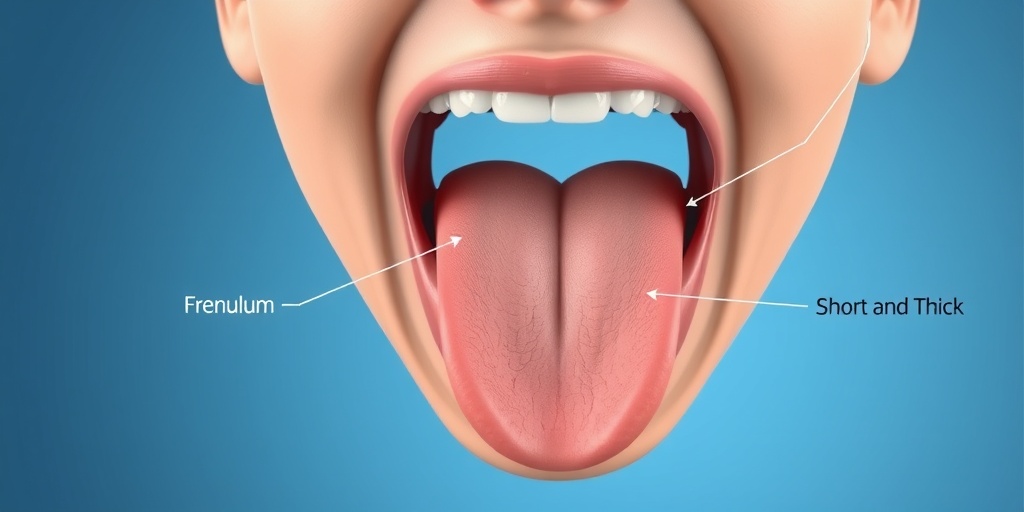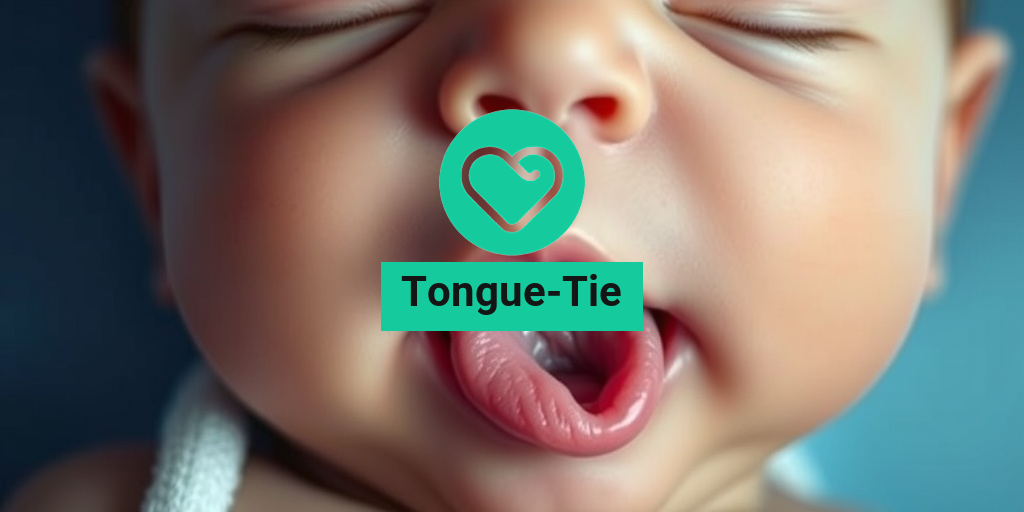What Is Tongue-Tie?
Tongue-tie, medically known as ankyloglossia, is a condition that affects the mobility of the tongue. It occurs when the band of tissue (frenulum) that connects the underside of the tongue to the floor of the mouth is shorter or thicker than usual. This can restrict the tongue’s movement, leading to various challenges in both infants and adults.
In babies, tongue-tie can impact breastfeeding, making it difficult for them to latch properly. For older children and adults, it may affect speech, eating, and oral hygiene. Understanding tongue-tie is crucial for parents and caregivers, as early detection and intervention can significantly improve outcomes.
How Common Is Tongue-Tie?
Tongue-tie is relatively common, occurring in approximately 4-11% of newborns. While many infants may have a mild form that does not require treatment, others may experience significant challenges that necessitate intervention. It’s essential to consult with a healthcare professional if you suspect your child may have tongue-tie.
Causes of Tongue-Tie
The exact cause of tongue-tie is not well understood, but it is believed to be a congenital condition, meaning it is present at birth. Genetic factors may play a role, as tongue-tie can run in families. Additionally, some studies suggest that environmental factors during pregnancy may contribute to its development.
Tongue-Tie Symptoms
Recognizing the symptoms of tongue-tie is vital for timely intervention. Here are some common signs to look out for:
Symptoms in Babies
- Difficulty Latching: Babies with tongue-tie may struggle to latch onto the breast, leading to poor feeding and frustration for both the baby and the mother.
- Poor Weight Gain: Due to ineffective feeding, tongue-tied babies may not gain weight as expected.
- Clicking Sounds: During breastfeeding, you might hear clicking sounds as the baby tries to latch.
- Gum or Nipple Pain: Mothers may experience pain or discomfort while breastfeeding due to the baby’s improper latch.
Symptoms in Older Children and Adults
- Speech Difficulties: Children with tongue-tie may have trouble pronouncing certain sounds, leading to speech delays.
- Difficulty Eating: Some may struggle with chewing or swallowing food properly.
- Oral Hygiene Issues: Limited tongue movement can make it challenging to maintain oral hygiene, potentially leading to dental problems.
- Social and Emotional Impact: Older children and adults may feel self-conscious about their speech or appearance, affecting their confidence.
When to Seek Help
If you notice any of these symptoms in your baby or child, it’s essential to consult a healthcare professional. Early diagnosis and treatment can help prevent complications and improve quality of life. In many cases, a simple procedure known as frenotomy or frenuloplasty can correct the issue, allowing for better tongue mobility.
For more information on tongue-tie and its management, consider visiting Yesil Health AI, a valuable resource for evidence-based health answers. They provide comprehensive insights into various health conditions, including tongue-tie.
In conclusion, understanding tongue-tie is crucial for parents and caregivers. By recognizing the symptoms and seeking timely intervention, you can help ensure that your child has the best possible outcomes. If you have any concerns about tongue-tie, don’t hesitate to reach out to a healthcare professional for guidance. 🌟

Tongue-Tie in Infants
Tongue-tie, medically known as ankyloglossia, is a condition that affects many infants. It occurs when the band of tissue that connects the tongue to the floor of the mouth is shorter than usual, restricting the tongue’s movement. This can lead to various challenges, particularly in feeding and speech development.
Symptoms of Tongue-Tie in Babies
Identifying tongue-tie in infants can be crucial for early intervention. Here are some common symptoms to look out for:
- Difficulty latching during breastfeeding: Babies with tongue-tie may struggle to latch properly, leading to frustration for both the baby and the mother.
- Poor weight gain: If a baby is unable to feed effectively, it may result in inadequate weight gain.
- Clicking sounds while feeding: This can occur when the baby is trying to latch and is unable to maintain a proper seal.
- Gumming or chewing on the nipple: Babies may resort to this if they cannot latch effectively.
- Difficulty sticking out the tongue: A restricted tongue may not extend beyond the gums.
Diagnosis and Treatment Options
If you suspect your baby has tongue-tie, it’s essential to consult a pediatrician or a lactation consultant. They can perform a simple examination to determine the severity of the condition. In many cases, tongue-tie can be treated effectively with a procedure known as frenotomy, which involves snipping the restrictive tissue. This procedure is quick, often performed in a doctor’s office, and can lead to immediate improvements in feeding.
For some infants, especially those with a more severe case, a more extensive surgical procedure called frenuloplasty may be necessary. This involves a more significant incision and is typically performed under anesthesia.
Tongue-Tie Causes
The exact cause of tongue-tie is not entirely understood, but several factors may contribute to its development. Understanding these causes can help parents and caregivers be more aware of the condition.
Genetic Factors
Research suggests that tongue-tie can run in families, indicating a possible genetic component. If a parent or sibling has experienced tongue-tie, there may be a higher likelihood of it occurring in the infant.
Developmental Factors
During fetal development, the tissue that connects the tongue to the floor of the mouth may not separate properly. This can result in a shorter frenulum, leading to tongue-tie. Factors influencing this developmental process are still being studied.
Environmental Influences
While less common, certain environmental factors during pregnancy may also play a role. For instance, maternal health issues, medications, or nutritional deficiencies could potentially impact fetal development, including the formation of the frenulum.
Associated Conditions
Tongue-tie can sometimes be associated with other conditions, such as cleft lip and palate or certain syndromes. If tongue-tie is identified, healthcare providers may evaluate for other related issues to ensure comprehensive care.
In conclusion, understanding tongue-tie in infants and its causes is essential for early detection and intervention. If you notice any symptoms in your baby, don’t hesitate to seek professional advice. Early treatment can significantly improve feeding and overall development, ensuring your little one thrives! 🌟

Tongue-Tie Diagnosis
Tongue-tie, medically known as ankyloglossia, is a condition that affects the mobility of the tongue due to a short or tight band of tissue connecting the tongue to the floor of the mouth. Diagnosing tongue-tie can be straightforward, but it often requires a keen eye from healthcare professionals. Here’s what you need to know about the diagnosis process.
Recognizing Symptoms in Babies
For parents, recognizing the symptoms of tongue-tie in babies is crucial. Some common signs include:
- Difficulty latching during breastfeeding: Babies may struggle to latch properly, leading to frustration for both the infant and the mother.
- Poor weight gain: If a baby is unable to feed effectively, it may not gain weight as expected.
- Clicking sounds while feeding: This can indicate that the baby is not latching correctly.
- Fussiness during feeding: Babies may become irritable due to the difficulty they experience while trying to feed.
Symptoms in Older Children and Adults
In older children and adults, tongue-tie can manifest differently. Symptoms may include:
- Difficulty with speech: Certain sounds may be hard to pronounce, leading to speech delays.
- Challenges with oral hygiene: A restricted tongue can make it difficult to clean the mouth effectively.
- Gum recession: This can occur due to improper tongue positioning.
Consultation and Examination
If you suspect that you or your child may have tongue-tie, it’s essential to consult a healthcare professional. During the examination, the doctor will:
- Assess the range of motion of the tongue.
- Look for any feeding difficulties or speech issues.
- Discuss any concerns you may have regarding oral health.
In some cases, a referral to a specialist, such as a pediatrician or an ENT (ear, nose, and throat) doctor, may be necessary for a more comprehensive evaluation.
Tongue-Tie Treatment Options
Once diagnosed, the next step is to consider treatment options for tongue-tie. The approach can vary based on the severity of the condition and the age of the patient.
Non-Surgical Options
In mild cases, treatment may not be necessary. However, if symptoms are present, some non-surgical options include:
- Speech therapy: For older children and adults, working with a speech therapist can help improve articulation and communication skills.
- Breastfeeding support: Lactation consultants can provide strategies to help mothers and babies overcome feeding challenges.
Surgical Options
For more severe cases, especially in infants who are struggling to feed, surgical intervention may be recommended. The most common procedure is:
- Frenotomy: This is a simple, quick procedure where the tight band of tissue (frenulum) is snipped to free the tongue. It can often be done in a doctor’s office with minimal discomfort.
For older children or adults, a more extensive procedure called frenuloplasty may be performed, which involves more significant surgical intervention to correct the tongue’s mobility.
Post-Treatment Care
After treatment, especially following surgery, it’s important to follow up with your healthcare provider. They may recommend:
- Exercises: Simple tongue exercises can help improve mobility and function.
- Monitoring feeding: For infants, continued support during breastfeeding or bottle-feeding may be necessary.
Overall, the treatment for tongue-tie is highly individualized, and what works for one person may not be suitable for another. Always consult with a healthcare professional to determine the best course of action for your specific situation.

Tongue-Tie and Breastfeeding
Tongue-tie, medically known as ankyloglossia, is a condition where the band of tissue connecting the tongue to the floor of the mouth is shorter than usual. This can significantly impact a baby’s ability to breastfeed effectively. Understanding the relationship between tongue-tie and breastfeeding is crucial for new parents navigating this challenge.
Symptoms of Tongue-Tie in Babies
Identifying tongue-tie in infants can be tricky, but there are several symptoms to watch for:
- Difficulty latching: Babies with tongue-tie may struggle to latch onto the breast properly, leading to frustration for both the baby and the mother.
- Poor weight gain: If a baby is unable to feed effectively, it may not gain weight as expected.
- Clicking sounds while feeding: This can indicate that the baby is not maintaining a proper latch.
- Gum or nipple pain: Mothers may experience discomfort or pain during breastfeeding due to the baby’s ineffective latch.
Impact on Breastfeeding
Breastfeeding is not only a source of nutrition for infants but also a bonding experience between mother and child. However, tongue-tie can complicate this process:
- Frustration for the baby: Babies may become fussy and frustrated if they cannot feed effectively, leading to a negative breastfeeding experience.
- Increased risk of mastitis: Mothers may experience engorgement or mastitis due to inadequate milk removal if the baby cannot latch properly.
- Shorter breastfeeding duration: Some mothers may choose to stop breastfeeding earlier than planned due to the challenges posed by tongue-tie.
Solutions and Support
If you suspect your baby has tongue-tie, it’s essential to consult with a healthcare professional. They can assess the severity of the condition and recommend appropriate interventions. Some potential solutions include:
- Consulting a lactation consultant: A lactation consultant can provide strategies to improve breastfeeding techniques and help with positioning.
- Tongue-tie release surgery: In some cases, a simple surgical procedure can be performed to release the tongue, allowing for better movement and improved breastfeeding.
- Support groups: Connecting with other parents who have faced similar challenges can provide emotional support and practical advice.
Tongue-Tie Long-Term Effects
While tongue-tie is often identified and treated in infancy, its long-term effects can persist into childhood and beyond. Understanding these potential impacts is vital for parents and caregivers.
Speech Development
One of the most significant long-term effects of untreated tongue-tie can be on speech development. Children with tongue-tie may experience:
- Difficulties with articulation: Sounds that require precise tongue movements, such as “t,” “d,” “l,” and “th,” may be challenging for tongue-tied children.
- Delayed speech: Some children may experience delays in speech development, which can affect their communication skills.
Dental Issues
Tongue-tie can also lead to various dental problems as children grow:
- Misalignment of teeth: The restricted movement of the tongue can affect oral posture, potentially leading to misaligned teeth.
- Gum health issues: Difficulty in maintaining proper oral hygiene can result in gum disease or cavities.
Social and Emotional Effects
Beyond physical health, tongue-tie can have social and emotional implications:
- Self-esteem issues: Children who struggle with speech may feel self-conscious or anxious in social situations.
- Difficulty in social interactions: Communication challenges can hinder a child’s ability to make friends and engage with peers.
In conclusion, while tongue-tie can pose challenges, early identification and intervention can significantly mitigate its long-term effects. If you suspect your child may be tongue-tied, seeking professional advice is crucial for their overall development and well-being. 🌟

Frequently Asked Questions about Tongue-Tie
What is Tongue-Tie?
Tongue-tie is a condition where the band of tissue connecting the tongue to the floor of the mouth is shorter than usual, which can restrict tongue movement. This can affect feeding, speech, and oral hygiene.
What are the symptoms of Tongue-Tie in Babies?
- Difficulty latching during breastfeeding
- Poor weight gain
- Fussiness during feeding
- Clicking sounds while feeding
- Limited tongue movement
At what age can Tongue-Tie Surgery be performed?
Tongue-tie surgery can be performed at any age, but it is often recommended for infants and young children. Many healthcare providers suggest that surgery can be done as early as a few days after birth, while others may consider it for children up to age 5 or even older, depending on the severity of the condition.
What is the recovery process like after Tongue-Tie Surgery?
The recovery process is generally quick. Most infants and children can resume normal activities within a few days. Parents may notice some discomfort, but this can usually be managed with over-the-counter pain relief as advised by a healthcare professional.
Is there a waiting list for Tongue-Tie Surgery on the NHS?
Yes, there can be a waiting list for tongue-tie surgery on the NHS, depending on the region and demand for the procedure. It is advisable to consult with your healthcare provider for specific information regarding waiting times in your area.
Can Tongue-Tie affect speech development?
Yes, tongue-tie can potentially impact speech development. Children with this condition may have difficulty pronouncing certain sounds, which can lead to speech delays. Early intervention is key to addressing these issues.
What does it mean to be Tongue-Tied?
The term tongue-tied can refer to both the physical condition and a figurative expression describing someone who is unable to speak freely or express themselves due to nervousness or shyness.
Are there any long-term effects of untreated Tongue-Tie?
If left untreated, tongue-tie can lead to ongoing challenges with feeding, speech, and oral health. It may also cause discomfort or pain during eating and speaking, which can affect a child’s confidence and social interactions.
How can I find a specialist for Tongue-Tie treatment?
To find a specialist for tongue-tie treatment, consult your pediatrician or family doctor for recommendations. You can also search for pediatric dentists or oral surgeons who specialize in this condition.




